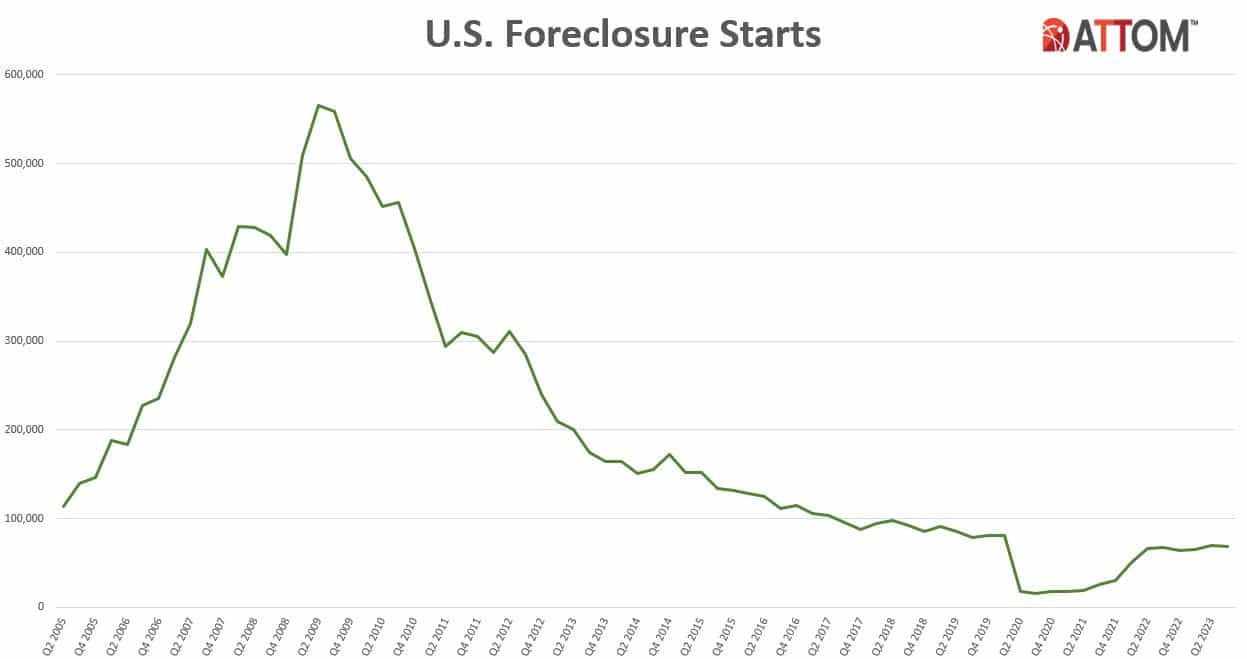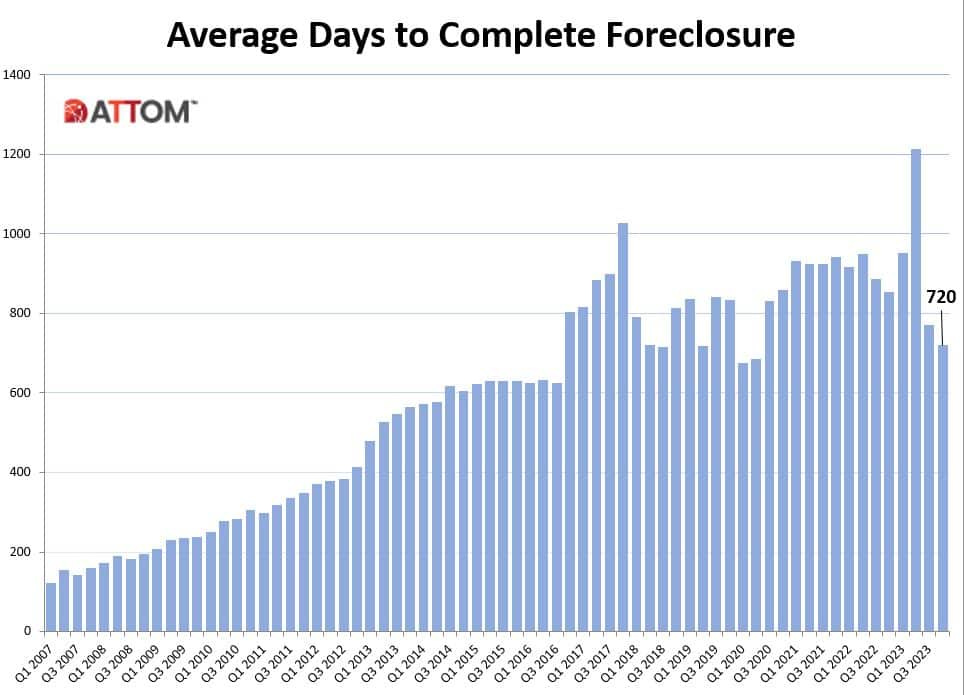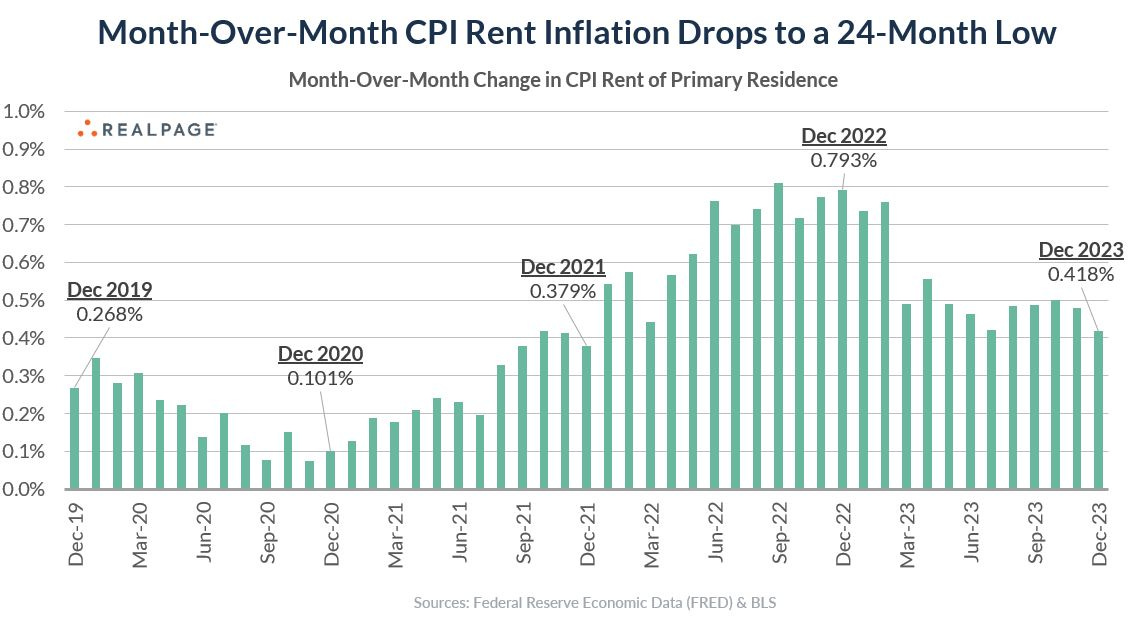Home foreclosures up 34% in 2024
Showcasing ongoing financial struggles for homeowners even as the economy shows signs of improvement.
Foreclosure filings in the U.S. are rising, marking an 18% uptick from last year as the nation grapples with post-pandemic economic hurdles.
FORECLOSURES INCH HIGHER
In ATTOM's latest scoop on real estate trends, there's a troubling spike in home foreclosures across the U.S. that can't be ignored. Picture this: in just the third quarter, we've seen foreclosure filings – that includes those dreaded default notices, auctions on the horizon, and homes taken back by banks – jump by a whopping 28%, hitting a hard-to-fathom 124,539 cases. That's a hefty 18% climb from the same time last year, really spotlighting the financial hurdles still tripping up a lot of American homeowners.
The report, which keeps tabs on default notices, scheduled auctions, and bank repossessions, tells us that 357,062 U.S. properties were in the foreclosure mix in 2023. That's definitely a jump from the past few years, but it's still way below the sky-high numbers we saw in the last decade, hinting that the market might be finding its feet after a bit of a rollercoaster ride.
Key Trends: About 0.26% of all U.S. housing units were in the fray, a tiny hike from 2022, yet still chill compared to 2019. The report kind of waves a flag of market correction, not crisis. We're talking about foreclosure starts on 270,222 properties, up 9% from last year, but still not hitting 2019 levels.
Regional Focus: Large states like California, Texas, and Florida are leading the pack in foreclosure starts. But when it comes to state foreclosure rates, New Jersey, Illinois, and Delaware are topping the charts. Big metro areas aren't immune either – New York and Chicago are seeing their fair share of foreclosure starts and bank repossessions.
👀Looking Ahead: This report is pointing towards a foreclosure landscape that's getting a bit more predictable. Sure, there's an uptick from last year, but the drop from the peak times suggests a housing market that's slowly syncing up with the bigger economic picture. The average days to complete a foreclosure fell, seeing a 7% decrease from the previous quarter, stacking on top of a 16% decrease from the previous year.
⬇️The Bottom Line: Even though foreclosure filings saw a 10% uptick in 2023, there's a silver lining for the U.S. housing market, as it's steadying its course with rates comfortably below those pre-pandemic peaks, hinting at a market that's slowly but surely syncing with the wider (positive) economic indicators.
Links of the Day
🧑🏫️Our Picks
Cooling costs: 🌡️ Despite a bump to 3.4% from November's 3.1%, the inflation cool-down persists into December, offering mixed signals to the Fed and economic policymakers.
Refinancing roulette: 🎲 Soaring interest rates are squeezing net operating incomes and making debt refinancing riskier, leaving property owners with $1.5 trillion in maturing debts facing tough choices.
Building momentum: 🏗️ Dodge Data Analytics reports a 3% increase in the Dodge Momentum Index for December, signaling a potential rebound in commercial and institutional construction planning.
🏭Industrial
Construction blues: 🚧 With 390 million square feet of unleased industrial space under construction set to complete soon, CoStar predicts further increases in vacancy rates across the U.S.
Industrial pushing out office: 🏗️ The pandemic prompts a rise in industrial space as North American suburbs see office buildings morph into warehouses and manufacturing hubs, with a 33.7% increase in conversions.
👪 Multifamily
Mycelium magic: 🍄 Ecovative's MycoComposite gives life to The Phoenix's façade in Oakland—carbon-negative panels that boast natural resistance and insulation properties for green living.
Rental retreat: 📉 Multifamily rents dipped for the fifth month in a row in December, with Yardi Matrix reporting a slight decline to an average of $1,709, amidst a backdrop of softening growth and stable occupancy.
Financing forecast: 💰 Lenders show a keener appetite than borrowers in the current climate; however, both parties anticipate increased volumes in commercial real estate finance next year.
🏷 Retail
High-street hustle: 💸 The high-end retail market in NYC continues its upward trend as consumers flock back to the city's iconic shopping streets, marking a post-pandemic economic pulse.
Retail revitalization: 🛍️ Avison Young broadens its horizons, acquiring Madison Marquette's full retail services to enhance its platform in 10 key U.S. markets, injecting fresh expertise and over 6.1 million square feet of retail space into their portfolio.
💼 Office
Dynamic deals are back: 🔄 With clarity on values and easing rate hikes, investors are re-entering the market, evidenced by a 16% rise in bids per deal, suggesting that the freeze in transactions may be thawing.
Waterfront windfall: 🌊 Strada Investment Group snaps up an 18-story office tower on San Francisco's waterfront for a mere $67.2 million, a stark 30% of its pre-pandemic valuation.
📊Daily Data Visualization
Recent inflation data indicates a cooling trend in the rental market, with December's month-over-month rent increase marking the lowest in 24 months. The Consumer Price Index (CPI) for rent inflation in December 2023 was notably just half of that in December 2022.
Stripping away the lagged shelter and rent components would put 2023's inflation at a mere 1.88%, squarely within the Federal Reserve's desired range. Shelter, heavily influenced by rents, constitutes one-third of the CPI basket.
The CPI measures shelter costs through Owners Equivalent Rent (OER) and Rent of Primary Residence, primarily based on surveys from renters rather than homeowners or home prices. This method has been consistent since home prices were removed as a variable from CPI calculations in 1981.
Lag effects are significant due to CPI's methodology of capturing net changes across all leases and conducting renter surveys biannually. New lease asking rents indicate a dramatic slowdown, especially when compared to the slower-moving CPI metrics for existing leases.
Therefore, while new lease asking rents are showing signs of stabilization, it is anticipated that there will be a delay before these trends are fully reflected in broader inflation measures like the CPI due to its inherent lag effect.
Follow us on Linkedin.
AI Audio Narration by Eleven Labs






